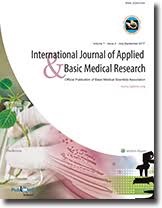Authors' Reports
|
Muhammad Shoaib Khan describes for SIIC the most significant aspects of his article describe para SIIC los aspectos relevantes de su artículo male infertility CONCENTRATION OF SEMINAL PLASMA ZINC IN VARIOUS CLASSES OF INFERTILE MALE The present study was designed to analyze the level of seminal zinc among different groups of infertile males and to correlate it with sperm concentration, active, sluggish and immotile fractions of seminal parameters, with an objective being to establish the role of zinc. This descriptive analytical study was carried out in the Department of Reproductive Physiology/Health, Public Health Laboratories Division, National Institute of Health, Islamabad in a 5 years period from 2002 to 2006. The result showed that seminal zinc was 702.92 ± 10.60, 598.48 ± 12.95, 617.54 ± 9.55, 542.29 ± 22.75, 710.36 ± 7.87, 712.06 ± 7.96, 789.36 ± 21.33 and 762.06 ± 8.99 in azoospermic, oligozoospermic, asthenozoospermic, oligoasthenozoospermic, teratozoospermic, normozoospermic, polyzoospermic and proven fathers group, respectively. Findings of the study showed that semen zinc was several folds higher in polyzoospermic subjects as compared to other groups, while it was found to be lower in oligozoospermic, azoospermic and oligoasthenozoospermic groups. In case of proven fathers, the levels of semen zinc varied non significantly (p > 0.05) with polyzoospermic cases. It is concluded from the results of the study that decreased concentration of seminal plasma zinc affect sperm count while increased level causes decreased sperm motility. The article was published by El artículo fue publicado por
Principal institution where the research took place Institución principal de la investigación Public Health laboratories Division, national Institute of Health, Islamabad, Pakistan, Isalamabad, Islamabad, Pakistan  Authors' Report Crónica del Autor Bibliographic references Referencias bibliográficas Nieschlag E. Scope and goals of Andrology. In: Andrology- male reproductive health and dysfunction. Nieschlag, E. and Behre, H.M. (eds.). springer Verlag, Berlin, Federal Republic of Germany; 1997. Pp. 1-8. Wong WY, Thomas CM, Merkus JM, Zielhuis GA. Male factor sub-fertility: Possible causes and the impact of nutritional factors. Fertility and sterility 73:435-442, 2000. Omu AE, Dashti H, Mohamed AT, Mattapallil AB. Significance of trace elements in seminal plasma of infertile men. Supplement to nutrition 11(5):502-505, 1995. Madding CL, Jacob M, Ramsay VP, Sokol RZ. Serum and semen zinc levels in normospermic and oligozoospermic men. Ann Nutr Metab 30(4):213-218, 1986. Wong WY, Flik G, Groene PM, et al. The impact of calcium, magnesium, zinc and copper in blood and seminal plasma on semen parameters in men. Reprod Toxicol 15(2):131-136, 2001. WHO. WHO laboratory manual for the examination of human semen and sperm-cervical mucus interaction. Cambridge University Press, Cambridge; 1992. Pp.1-107. Johnsen O, Eliasson R. Evaluation of a commercially available kit for the colorimetric determination of zinc. Int J Andr 10(2):435-40, 1987. Atiken RI, Aribarg A, Gopal Krishnan K, Hamiltion DW, Katz DF, Wang C, Vanlook PFA. Collection and examination of human semen. WHO laboratory manual for the examination of human semen and sperm cervical mucus interaction. Cambridge University Press; 1980. Henkel R, Bittner J, Weber R, Huther F, Miska W. Relevance of zinc in human sperm flagella and its relation to motility. Fertil Steril 71(6):1138-143, 1999. Mc-Graw H. A study ties zinc deficiency to male infertility. Med World News 20(12):12-16, 1979. Kvist U, Kjellberg S, Bjorndahl L, Sourfir JC, Arver S. Seminal fluid from men with agenesis of the wolffian ducts: zinc binding properties and effects on sperm chromatin stability. Int J Androl 13:245-52, 1990. Chia SE, Ong CN, Chua LH, Ho LM, Tay SK. Comparison of zinc concentrations in blood and seminal plasma and the various sperm parameters between fertile and infertile men. J Androl 21(1):52-57, 2000. Saeed S, Khan FA, Rehman SB, Khan DA, Ahmad M. Biochemical parameters in evaluation of oligospermia. J.P.M.A 44:137-140, 1994. Aslam M, Khan FA, Saeed S, Ahmed A. The concentration of semen fructose, zinc and plasma reproductive hormones in sub fertile men. P.J.M.R. 35(4):157-160, 1996. Stankovic H, Mikac-Devic D. Zinc and copper in human semen. Clin Chem Acta 70:123-126, 1976. Riffo M, Leiva S, Astudillo J. Effect of zinc on human sperm motility and acrosome reaction. Int J Androl 15:229-237, 1992. Stegmayr B, Ronquist G. Stimulation of sperm progressive motility by organelles in human seminal plasma. Scand J Urol Nephrol 16:85-91, 1982. Carreras A, Mendoza C. Zinc levels in seminal plasma of fertile and infertile men. Andrologia 22:279-83, 1990. Fuse H, Kazama T, Ohta S, Fujiuchi Y. Relationship between zinc concentrations in seminal plasma and various sperm parameters. Int Urol Nephrol 31(3):401-408, 1999. Other articles written by the author Muhammad Shoaib Khan Otros artículos de Muhammad Shoaib Khan 1. Khan, M. S., Shahnaz, Sultana R, Ali I. factors affecting serum ferritin level in School going children of District Bannu. JPostgrad Med Inst 2012; 26(3):237-41. 2. Khan, M. S., Deepa ,F., Ahmed,Z., Tahir, F., & Khan, MA., Assessment of male reproductive health by conventional method of semen analysis. JAMC 2011; 23(1):84-88. (Impact factor 0.0) 3. Khan, M. S., Dilawar, S., Ali, I., Rauf N. The Possible role of Selenium Concentration in hepatitis B & C patinets. Saudi J gasterentrol. 2012; 18(2):106-10. (International-Impact factor 0.7) 4. Khan, M. S., Ullah, R., Tahir, F., Sajjad M. Seminal volume in the investigation of male infertility. JCPSP. 2012; 22(3):159-162. (Impact factor 0.55) 5. Khan, M. S., Zaman S., Sajjad M., Shoaib M., & Jilani G. Assessment of the level of trace element zinc in seminal plasma of males and evaluation of its role in male infertility. IJABMR. 2011; 1(2):93-96. (International) 6. Khan, M. S., Majid, A., Sajjad M., Ullah, S. 2011. Hepatitis B & C: An alarming situation in southern part of Khyber paktunkhwa. Annals of PIMS:7(4):228-232. 7. Akhtar T., Khan, M. S., Ahmed, I., Ahmed I. Family planning practices in model village of rural community in Pakistan: a 16 year experience. JPMI 2011; 25(4):318-23. 8. Majid A., Khan, M. S., Fiaz M. Unusual Presentation of Falciparum Malaria as Generalized Anxiety Disorder at DHQTH, Bannu. Ann.Pak. Inst. Med. Sci. 2011; 7(1):26-28. 9. Alam W., Khan, M. S., Akhtar, J., Bibi,R., Shabir A, Qazi BM.. Trend of Fertility potentials with Increasing Age in Pakistani Males. JPMI 2011; 25(1):9-13. 10. Khan, M. S., Jehan,S., Ahmed,Z., Khan S, Zaman S, & Shah FU. Relationship between blood group and male infertility. JAMC 2010; 22(1):154-156. (Impact factor 0.0) 11. Khan, M. S., Jehan,S., Ahmed,Z., Khan S, Zaman S, & Shah FU. Common trend of antibiotic usage in tertiary care Hospital of Khber pakhtun Khwa JAMC 2010; 22(1):118-120. (Impact factor 0.0) SIIC System of Assisted Editing (SSEA) / Sistema SIIC de Edición Asistida (SSEA)
The article is strictly related to the following sections of siicsalud El artículo se relaciona estrictamente con las siguientes secciones de siicsalud
Information about the full text Acerca del trabajo completo Assessment of the Level of Trace Element Zinc in Seminal Plasma of Males and Evaluation of its Role in Male Infertility Author / Autor Muhammad Shoaib Khan1, Fariyal Deepa2 2 Senior Sentific Officer, Reproductive Physiology/health, Nih, Islamabad, Senior Sentific Officer Article URL: / URL del artículo: http://www.ijabmr.org/aboutus.asp siic DB: / siic DB: http://www.siicsalud.com/main/distriprinrel.php |
||||||||||||||||||||||||||
ua32218










































